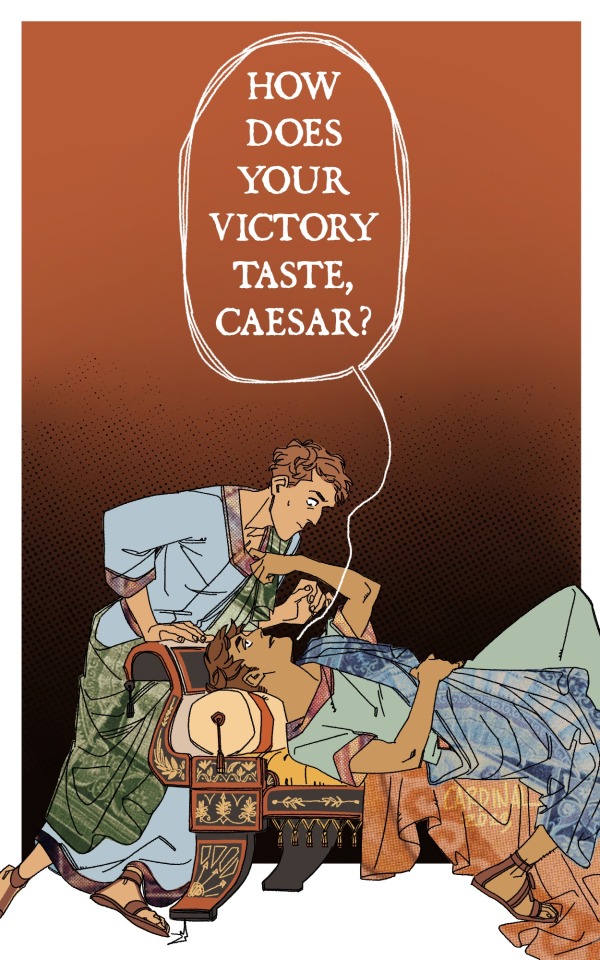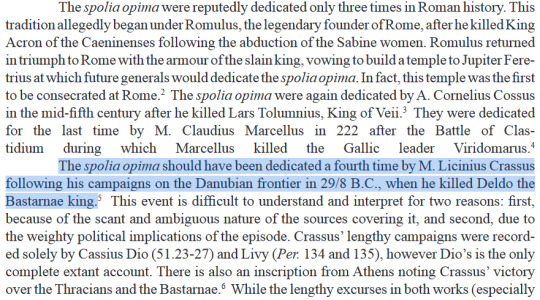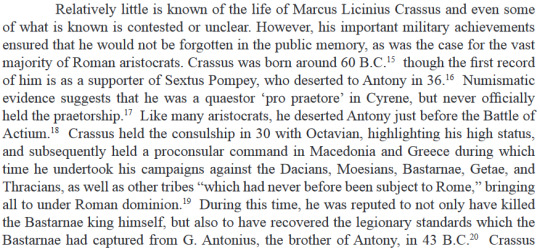#roman slavery
Explore tagged Tumblr posts
Text

Cupid Fleeing from Slavery
Artist: Joseph-Marie Vien (French, 1716–1809)
Date: 1789
Medium: Oil on canvas
Collection: Musée des Augustins, Toulouse, France
Description
"Cupid Fleeing From Slavery" depicts the Roman god of love, Cupid, escaping from a situation where he is being held captive, often symbolized by chains or bonds, usually with a frantic and energetic movement, signifying his desire for freedom and the inherent power of love to break free from constraints; it's a classic representation of love's rebellious nature and its resistance to being controlled
#mythological art#oil on canvas#painting#cupid#slavery#female figures#classic architecture#table#chaise#statue#roman mythology#god of love#empty cage#joseph marie vien#french painter#french art#classic pillars#artwork#oil painting#18th century painting
14 notes
·
View notes
Text
No one should be allowed to publish their "slave fic romance" or "master/slave" (published or fanfiction) until they've been (1) put through the rigors of historical slavery texts and (2) can demonstrate critical thinking and analysis about the severity of slavery and how it still influences our societies today. In particular, how [white] folks have minimized it on various levels.
That shit is not a "kink" or wank material, you closeted white supremacist.
#greatrunners meta#greatrunner talks about writing#slavery#fanfiction#books#firebird#chattel slavery#roman slavery#antiblackness
13 notes
·
View notes
Text
This sounds like it was an absolutely miserable existence.
50 notes
·
View notes
Text

#feetpics#male beauty#male physique#masculine beauty#roman slavery#roman soldiers#roman empire#bdsmdominant#bdsmslave#bdsmbondage#slim twink#cute twink#twink#homoerotic
4 notes
·
View notes
Text
“General,” he stated, chest heaving in exertion, but a small smile on his lips. “It is good to see you man alive, sir.”
“I would like to say the same of you, Piett, but I can see you are injured. Where…?”
But he’d spotted the arrow lodged in the man’s chest, right near the collarbone where the leather of his cuirass did not cover.
Piett nodded and made no effort to dismount even though his horse had stopped, her head hanging low and her sides heaving.
“Lucky shot,” he managed, listing a little in the saddle. “Not…not life threatening, but inconvenient. I…”
But he really did begin to tip here and Max swore, leaping forward along with Travus to catch him as he slid slowly from the saddle.
And that was blood all down the saddle and the mare’s sweating flank…
“Firmus,” Max breathed, fear freezing his lungs.
#star wars#star wars original trilogy#star wars au#Star wars Roman au#roman britain#Piett is a Briton#veers a Roman#firmus piett#admiral piett#general veers#maximilian veers#Roman slavery#slave and master#friendship#angst#loyalty#author loves history#and putting her favorites in situations#(sorry Piett)#hurt/comfort
7 notes
·
View notes
Text
There's a really good book on Roman Slavery called
Slavery in the Roman World by Sandra R Joshel
To start thinking about Roman slavery is to stare into an infinite abyss of deliberate human suffering. The Roman Empire is considered to be one of the genuine slave states in human history, in that, like the antebellum Southern states of America, it could not exist without slavery. Slavery was the social and economic foundation upon which the entire Roman Empire rested. But while the slave states of Louisiana and Virginia lasted 150 years before abolition, the Roman Empire stood on the backs of unimaginable numbers of enslaved men, women and children for almost a thousand years. A thousand years is thirty-four generations of people enslaved to the Romans. A thousand years before the year I wrote this, King Cnut was glaring down the sea. A thousand years is an immense amount of time. And they didn’t just have domestic slaves, they had vast mines across the Empire for silver, lead, gold, iron and copper. Google the Las Médulas mines in Spain and imagine the sixty thousand enslaved people who worked there twenty-four hours a day to produce the gold the Roman Empire demanded, and then multiply that by hundreds of years and hundreds of sites and all those lives that were sent to toil for nothing and join me staring into this bottomless pit of Roman horror. Then picture the near infinite acres of land owned by the Gaius Caecilius Isidoruses and Melanias of the Roman world, each maintained by chain gangs of hundreds of enslaved people. And on top of that were those enslaved in the house, the cooks and cleaners and washers and dressers, the people enslaved by the state who maintained the aqueducts and laid the roads and built all those temples and fora across the vast Empire and fought fires and carried the emperor in his litter. A general estimate (which means, of course, a total guess but a guess from someone I’d trust in a quantitative situation) is that there were between 4.8 and 8.4 million enslaved people in the Roman Empire at any time, with the city of Rome‘s population including anywhere from ten to twenty-five percent enslaved people. Millions and millions and millions of lives, each a person with a heart full of love and hate and envy and joy and aching knees and sore eyes and dreams and thoughts and desires and hopes, all of whom were owned by another person and subject to the most extraordinary violence every day.
A Fatal Thing Happened on the Way to the Forum: Murder in Ancient Rome by Emma Southon
#Sandra r joshel#sandra joshel#Roman slavery#slavery#slavery in ancient rome#slavery in the Roman world#slave states
20K notes
·
View notes
Text
On the one hand, slavery represented the most radical rural degradation of labour imaginable - the conversion of men themselves into inert means of production by their deprivation of every social right and their legal assimilation to beasts of burden: in Roman theory, the agricultural slave was designated an instrumentum vocale, the speaking tool, one grade away from the livestock that constituted an instrumentum semi-vocale, and two from the implement which was an instrumentum mutum. On the other hand, slavery was simultaneously the most drastic urban commercialization of labour conceivable: the reduction of the total person of the labourer to a standard object of sale and purchase, in metropolitan markets of commodity exchange.
— Perry Anderson (1974), Passages from Antiquity to Feudalism, pp. 24-25
I always knew that the Roman Empire probably wasn’t great to live in for a variety of reasons but reading about the obscene amounts of chattel slavery they were doing is really driving home why all the fascist guys on twitter are obsessed with this period of history
#book club#I mean Anderson is describing a lot of city-states in Antiquity in Europe during this time so it’s not exclusive to the Romans#but still. I wasn’t aware how widespread chattel slavery was. Like I thought it was a more modern invention
726 notes
·
View notes
Text
fandom talks too little about hylla and reyna. reyna killed her father when she thought he'd killed hylla. hylla dragged them out of puerto rico and found them sanctuary and employment on circe's island AND became one of circe's favorites. then when they got captured by blackbeard hylla also got them out of that situation by out-pirating literal immortal pirates. then in a span of three years, they split up, found their own ways to the amazons and cj, and became the leaders of their respective factions. when hylla's queenship was being threatened by otrera in son, she plotted a counter-coup and defeated an amazon queen who couldn't die two nights in a row in one-on-one combat, THEN led her cavalry to camp jupiter. (ik this woman slept like a corpse for a week afterwards). hylla used reyna as an absolutely ruthless bait-and-switch to capture orion, and all reyna said in response to that was, "bet." reyna carries insurmountable amounts of both guilt and gratitude towards her sister. even though they havent seen each other in a while, hylla still drops everything and does everything in her power to save her baby sister when she knows reyna needs her.
#like they are an ABSOLUTELY insane sibling duo. NO ONE IS DOING IT LIKE THEM#also the siblingism of committing indescribable sacrifices for each other then. never talking about it ever again. not even to say thanks.#so real#if not for the running trend of rick's female characters needing to either get a love interest or become celibate#i could almost accept reyna's joining the hunt as a 'ITS AWKWARD AROUND MY SISTER OK' thing LMFAO#also like can we talk about how shitty it is for rick to have written the amazons Like That#like ah yes the two women-run societies in the greco-roman verse:#the eternally celibate pre-teen girl scouts and the takes-femdom-too-seriously corporate shipping evil overlords#kmsing#rick wanted to do adult stuff soooooo bad in hoo but he cant write things that require more than 5 minutes of planning and worldbuildin#and the amazons were such a good example of that. so what we get is a 'teehee feminism girlboss men are beneath us' joke that feels#VERY UNCOMFORTABLE and wildly out of place in the pjoverse#the hunt is very often discussed in rr crit but the amazons not as much#unless it's to say like 'augh the amazons are so gross they're literally pro-slavery' which. my guy hylla and co did not make that#autonomous decision. rick did.#i need to stop this tag ramble somewhere so this will be it but i have so many thoughts about how hylla and reyna were handled#hylla ramirez arellano#reyna avila ramirez arellano#rr crit#my meta
215 notes
·
View notes
Text

Blood in the Arena: the Spectacle of Roman Power, Alison Futrell
#gladiator tag#honestly the roman slavery tag and the gladiator tags are functionally a circle#there is no meaner condition among the people than that of the gladiator etc etc etc#hm. let's get a book tag going#after hours book club
166 notes
·
View notes
Text
"Oh, please! You're from the Roman Camp, aren't you? Rome was built on slavery. Don't get all high and mighty with me!"
Rick, why do you throw the jabs only at Rome? I'm pretty sure Ancient Greece had slavery too. And I know this is just an example of Phineas being evil, but this is slander against Rome! Treating Rome like it's worse than other cultures! When we all know many civilizations had slavery, not just Rome. So really: Why do you seem to hate Rome, Rick Riordan!?
The only major roman we meet who has no connections to the greeks or any other pantheons is probably Octavian, and you portray him like a monster! Yet when you had Luke doing evil on the Greek side, you tried to paint him as a sympathetic antagonist! Why do you have such a prejudice against the mighty culture of Rome!? Why!?
#I didn't mean to sound like I was defending slavery#I'm not!#i just felt this line was unfairly biased against rome#but that's just how i saw it#percy jackson#pjo#pjo hoo toa#heroes of olympus#hoo#hoo series#roman mythology#roman culture#rick riordan#riordan universe#riordanverse
39 notes
·
View notes
Text

#feetpics#male beauty#male physique#masculine beauty#crucifixion#cute twink#creepy art#execution#bdsmdominant#bdsmslave#roman empire#roman soldiers#roman slavery
2 notes
·
View notes
Text

Romans 8:15 (NASB1995) - For you have not received a spirit of slavery leading to fear again, but you have received a Spirit of adoption as sons by which we cry out, “Abba! Father!”
14 notes
·
View notes
Text
Paris deserves the nuance people give Hades

Especially since there are actually sources where Helen goes willingly …ok, we all know Aphrodite definitely played a part in her feelings
but the point it’s not all Paris’s fault and I’ve seen Zeus get more blame for Hades kidnapping Persephone than Aphrodite or any of the gods get in the Paris situation.
It's always "fuck Paris" "Paris" this "Paris" that, while everyone goes their merry way simping for niecenapper Hades who doesn't have a single historic myth that claims Persephone went willingly.
#I say this as someone who LIKES Hades ships Hades x Persephone and does not ship Paris x Helen (caused waaaay too much trouble)#Maybe someone who was doomed at birth grew up in slavery was forced to pick between 3 goddesses who withheld important information from him#and overall has to deal with an uncomfortable power dynamic with literal gods deserves some sympathy actually.#paris of troy#helen of sparta#hades#persephone#greek gods#greek myth#greek mythology#greco roman mythology
7 notes
·
View notes
Text
Sexual violence and exploitation are inherent to imperialism and any discussion of imperialism that shies away from these subjects is disingenuous and flawed. I know lots of people on this site (myself included) engage with Ancient Rome and its history as a hobby, but that is not an excuse to not be aware or willing to discuss the unsavoury parts of its existence and legacy.
#mags babs#listen I too am guilty I have a lot of books about Roman slavery on my tbr list I haven’t gotten to yet. but we must be willing to engage#in these discussions
30 notes
·
View notes
Text

CAESAR AUGUSTUS AND MARCUS LICINIUS CRASSUS
this is about the spolia opima that crassus was robbed of lmao. like, yeah okay octavian could've asked him not to claim it, but nevertheless. a kind of theft happened there.




Fact and Fiction: Crassus, Augustus, and the Spolia Opima, Catherine McPherson
#this is one from the vaults I started a few months ago and finally finished. it’s always the furniture details that put things on hold lmao#the former co consuls are fightinggggg (?)#rome is built on top of other people. this is about both the imperialism-slavery machine and the way that all these guys would#politically devour their own generation to sit on a throne. etc. anyway. octavian specifically sits on a throne of other people’s#accomplishments. that’s a specific kind of debt to carry around your neck. or theft depending on who is doing what#this was theft. anything involving Agrippa was a gift so there’s an obligation to succeed which is it’s own kind of currency so to speak#sugghrhfh. every crassus always has to be like this. in my heart i always root for whoever decides to go up against rome#and then i'm stuck with the guy who should've got a spolia opima like. congrats on your win. i guess. i think. RIP.#ACTUALLY YOU KNOW WHAT. while im talking about this crassus. domina fucking sucks. what an absolute clusterfuck of a show#anyway. if anyone ever does augustan age politics again. octavia would be a great character if you want to invent shit#but also more importantly octavian should seduce crassus for this. thank you.#octavian#marcus licinius crassus.....christ how do i write down that he's the grandson of my crassus. i'll figure it out later#roman empire tag#drawing tag
367 notes
·
View notes
Text

getting a number of tags like these on my post and idk. like i want to say that i'm an extremely big fan of the importance of context & setting when it comes to approaching history, it's deeply important to keep in mind at every point. but at the same time i feel really weird about how much people feel the instinctive need to separate roman slavery and e.g. 19th century slavery, & how uncomfortable people seem to be with any comparison or association between the two beyond 'both being slavery'. there were absolutely notable differences (the racial aspect for a major one) but the way people seem to sort of historically quarantine them as things that happened entirely independently of each other & not acknowledge any similar systems or characteristics that might draw parallels between the two is. idk. i think historical comparison can be a very valuable tool & i feel like it's worth examining why people think there's nothing at all roman in 19th c slavery etc etc
#turning off rbs bc i'm honestly kind of sick of this topic but it's annoying me so. yeah.#idk that this is well expressed or phrased but it's something that's been bothering me since i was researching roman slavery last year#thoughts#slavery cw
36 notes
·
View notes